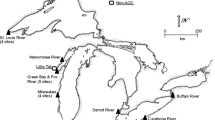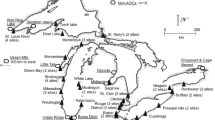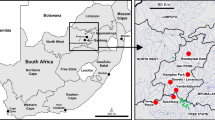Abstract
Within-clutch variability of DDE and PCB residues in eggs from 62 clutches of black-crowned night-herons (Nycticorax nycticorax) was small (12% and 17%) compared to among-clutch variability (88% and 83%). Significant correlations between concentrations of DDE (median r=0.8885) and of PCBs (median r=0.8244) occurred when 501 correlations were run on two randomly selected eggs from within the same clutch; no significant correlation occurred for either concentrations of DDE (median r=0.0353) or PCBs (median r=−0.0843) when eggs were not restricted to the same clutch but were restricted to the same colony. The probability of finding infrequently detected organochlorine contaminants (e.g., DDT, cis-chlordane) in eggs from the same clutch varied from 43–96% and increased as the chemical became more prevalent and the number of eggs per clutch became smaller. These results further support one of the basic assumptions of the sample egg technique, that the chemical residues in one egg in a clutch accurately reflect residues in the remaining eggs of the clutch.
Similar content being viewed by others
References
Blus, L. J.: 1982, ‘Further Interpretation of the Relation of Organochlorine Residues in Brown Pelican Eggs to Reproductive Success’, Environ. Pollut. 28, 15–33.
Custer, T. W., Erwin, R. M., and Stafford, C.: 1983a, ‘Organochlorine Residues in Common Tern Eggs from Nine Atlantic Coast Colonies, 1980’, Col. Water. 6,197–204
Custer, T. W., Hensler, G. L., and Kaiser, T. E.: 1983b, ‘Clutch Size, Reproductive Success, and Organochlorine Contaminants in Atlantic Coast Black-Crowned Night-Herons’, Auk 100, 699–710.
Custer, T. W. and Mitchell, C. A.: 1987, ‘Organochlorine Contaminants and Reproductive Success of Black Skimmers in South Texas, 1984’, J. Field Ornithol. 58, 480–489.
Efron, B. and Gong, G.: 1983, ‘A Leisurely Look at the Bootstrap, the Jackknife, and Cross-Validation’, Amer. Statis. 37, 36–48.
Milliken, A. G. and Johnson, D. E.: 1984, ‘Analysis of Messy Data, Vol. 1: Designed Experiments’, Lifetime Learning Publications, 473 pp.
Mineau, P.: 1982, ‘Levels of Major Organochlorine Contaminants in Sequentally-Laid Herring Gull Eggs’, Chemo. 11, 679–685.
Newton, I. and Bogan, J.: 1978, ‘The Role of Organo-Chlorine Compounds in the Breading of British Sparrowhawks’, J. Appl. Ecol. 15, 105–116.
Nisbet, I. C. T.: 1982, ‘Eggshell Characteristics and Organochlorine Residues in Common Terns: Variation with Egg Sequence’, Col. Water. 5, 139–143.
Ohlendorf, H. M., Klass, E. E., and Kaiser, T. E.: 1978, ‘Environmental Pollutants and Eggshell Thinning in the Black-Crowned Night Heron’, Wading Birds, in Sprunt, A. IV, Ogden, J. C., and Winckler, S. (eds.), National Audubon Society Research Report No. 7, pp. 63–82.
Ohlendorf, H. M., Hothem, R. L., Bunck, C. M., Aldrich, T. W., and Moore, J. F.: 1986, ‘Relationship between Selenium Concentrations and Avian Reproduction’, Trans. N. A. Wildl. Nat. Res. Conf. 51, 330–342.
Potts, G. R.: 1968, ‘Success of Eggs of the Shag on the Farne Islands, Northumberland, in Relation to their Content of Dieldrin and pp ‘DDE’, Nature 217, 1282–1284.
SAS Institute: 1985, ‘SAS User's Guide: Statistices Version 5 Edition’, SAS Institute Inc. Cary, NC, 957 pp.
Shapiro, S. S. and Wilk, M. B.: 1965, ‘An Analysis of Variance Test for Normality (Complete Samples)’, Biometrika 52, 591–611.
Snyder, N. F. R., Snyder, H. A., Lincer, J. L., and Reynolds, R. T.: 1973, ‘Organochlorines, Heavy Metals, and the Biology of North American Accipters’, Bio. Sci. 23, 300–305.
Thompson, N. P., Rankin, P. W., Cowan, P. E., Williams Jr., L. E., and Nesbitt, S. A.: 1977, ‘Chlorinated Hydrocarbon Residues in the Diet and Eggs of the Florida Brown Pelican’, Bull. Environ. Contam. Toxicol. 18, 331–339.
Vermeer, K. and Reynolds, L. M.: 1970, ‘Organochlorine Residues in Aquatic Birds in the Canadian Prairie Provinces’, Can. Field-Nat. 84, 117–130.
Author information
Authors and Affiliations
Rights and permissions
About this article
Cite this article
Custer, T.W., Pendleton, G. & Ohlendorf, H.M. Within-and among-clutch variation of organochlorine residues in eggs of black-crowned night-herons. Environ Monit Assess 15, 83–89 (1990). https://doi.org/10.1007/BF00454750
Issue Date:
DOI: https://doi.org/10.1007/BF00454750




